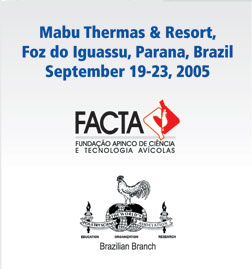Contributed Papers: Oral Presentations
Diagnosis and Epidemiology |
Counting coccidia:
a genomic approach
Damer P. Blake, Patricia Hesketh,
Andrew Archer,
Martin W. Shirley and Adrian L. Smith.
Institute for Animal Health, Compton,
Berkshire, RG20 7NN, UK.
Email: damer.blake@bbsrc.ac.uk
Quantification
of infection with the Eimeria spp. through monitoring
pathological severity or magnitude of oocyst excretion
has greatly informed our understanding of the Eimerian
life cycle. However, attempts to quantify fluctuations
in parasite reproduction within the host have largely
relied upon labour-intensive microscopic analysis,
creating a ‘grey box’. The development,
validation and application of a quantitative real-time
PCR assay has opened this biological ‘box’,
permitting the sensitive and reproducible enumeration
of intracellular parasite genomes present throughout
the course of infection. Generic and species-specific
quantitative PCR assays that target the conserved
5S ribosomal RNA coding sequence of nine avian and
murine Eimeria species and the E. maxima MIC1 gene
have been validated as capable of detecting >0.01
and >1 E. maxima genomes respectively. The generic
5S ribosomal RNA assay has been shown to enumerate
the genomes of E. acervulina, E. mitis, E. tenella,
E. pragensis and E. vermiformis with a comparable
sensitivity and efficiency to that recorded for E.
maxima over at least seven orders of magnitude. Preparation
of samples collected in vivo with a commercial DNA
extraction kit allowed the rapid enumeration of parasite
genomes within an excised tissue section in just two
working days. Parasite genomic DNA could first be
detected within the host three days after infection
with only 100 sporulated E. maxima oocysts.
Application of these complimentary generic and species-specific
assays to study the dynamics of E. maxima replication
within hosts representing ‘susceptible’
and ‘resistant’ genotypes indicate a brief
period of differential killing four to five days after
infection, suggesting that the third and fourth generation
schizonts, but not the gametocytes, are targeted by
the strain-specific host immune response. Other potential
applications for the quantitative PCR assays described
here include investigating the efficacy and point
of action of existing and novel chemotherapeutic compounds
and vaccine candidates, together with the continued
characterisation of the Eimerian life cycle.
